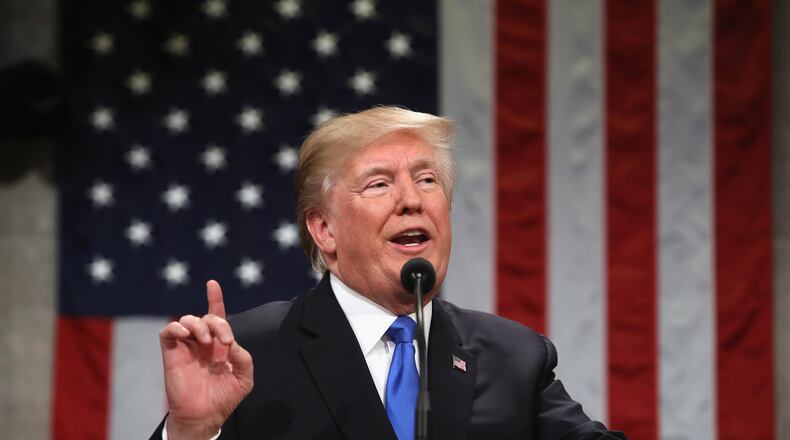It’s become fashionable in some quarters to pine for the days, long ago, when the State of the Union was a written document the president delivered to the Congress once a year rather than the seemingly-made-for-TV spectacle it has become. There are basically two types of people who make these calls: partisan opponents of the president who resent the rhetorical opportunity the SOTU provides, and serious policy wonks who lament the lack of actionable specifics in the modern version of these speeches. Both complaints are the precise reason presidents may never stop visiting the House chamber once a year to indulge in the spectacle.
I’m as policy-oriented as anyone, but credit where credit is due: The SOTU is a matter of political theater, and no one displays an understanding of that more than Donald Trump.
His first SOTU* was impressive for its command of stagecraft and narrative. I put a great deal of value on facts and truth, but it you’re getting hung up on the fact-checks of Trump’s speech you’re missing the point as it came across to the vast majority of viewers. What the vast majority of viewers heard was a broadly true message about how the economy is humming, how Trump is remaking American foreign and trade policy in his “America First” image, and how the long-running immigration debate is coming to a head.
More important is what the vast majority of viewers saw. Yes, they saw the president of the United States looking presidential before the flag, the speaker of the House and the vice president. But in this particular case, they saw two general groups of sights:
1. They saw ordinary people who have done extraordinary things that just so happen to align with some of Trump’s biggest priorities, from the Albuquerque police officer who stopped a pregnant mother from shooting herself up with heroin and then with his wife adopted the child she was carrying, to the families (note: racial and ethnic minority families) whose children were killed by members of the MS-13 gang that Trump has cited as a reason for cracking down on illegal immigration. And perhaps most powerfully, they saw Ji Seong-ho, who escaped from North Korea and after enduring one horror after another made it to the United States, stand up on his artificial leg and raise his crutches triumphantly over his head. All SOTUs include such guests in the audience, but what was different about this one (and somewhat out of character for this president) was the way Trump lingered on these stories and relied on them for such a significant portion of his speech.
2. And they saw, repeatedly, Democrats sitting and often not even clapping during some portions of the speech that should have drawn bipartisan acclaim.
Viewers saw this look, or a variation of it on other Democrats’ faces, a lot last night as Trump touted new investments by companies after Congress passed tax reform, historically low unemployment among African-Americans, and even the early success of some VA reforms:
You don’t have to like Trump very much to recognize Democrats’ stone-faced expressions often didn’t come off as principled or resolute, but petty and churlish. And he didn’t have to take any verbal swipes at them for the message to come across.
Now, you also don’t have to dislike Trump very much to recognize he can be his own worst enemy at times. There’s a pretty good chance he will step on his own success fairly soon with some comment or tweet; I didn’t publish these thoughts about his speech last night because I didn’t want to risk his tweeting irresponsibly before dawn. As I write this now, late in the morning, he hasn’t tweeted since before the speech.
But if Trump can refrain from the temptation to thumb his way to controversy, that speech can be a good template for how he and the GOP should approach the rest of this election year: Tout economic successes, and highlight the broad and even non-traditional coalition of people who would be helped by their policies. Given the lack of Democratic alternatives besides “we’re not him” and “impeach!”, that might be enough.
---
*Technically, the president does not deliver a SOTU in his first year of office, although traditionally he does deliver a joint address to Congress, as Trump did last year.
About the Author
The Latest
Featured


